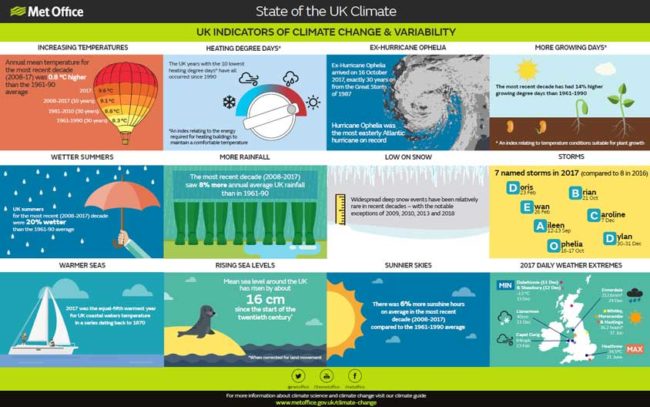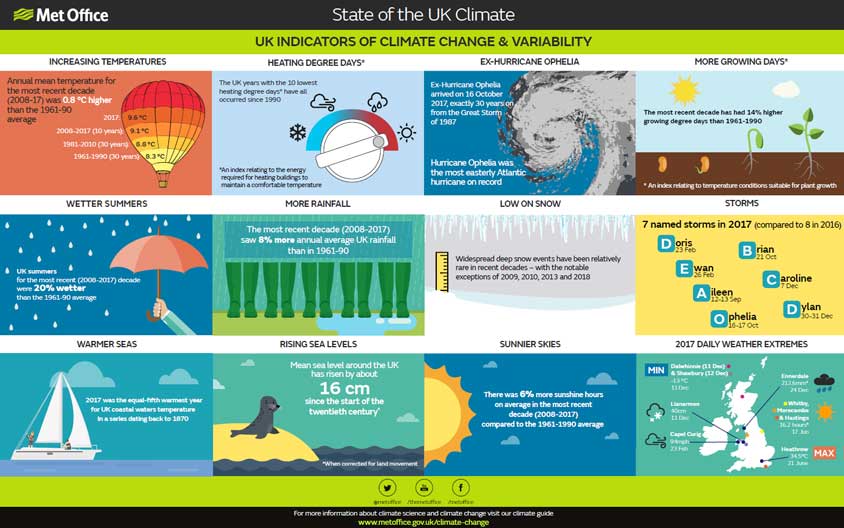 The UK’s Met office has published a full scientific report on the state of the climate in the UK.
The UK’s Met office has published a full scientific report on the state of the climate in the UK.
- The Press Release is here.
- The full report published within The International Journal of Climatology is here (open access).
The report is a summary of the UK climate in 2017 and places it all within the historical context. It is their fourth such report. The data they have used all comes from the Land-based weather stations managed by the Met office. Now pause and remember that they have records going back to 1659.
A weather report sounds dull, but hey, this is the UK, we love to talk about the weather.
The Climate is Changing
So the key point in highlighting it is this. Their official scientific conclusion based upon hard observational data is …
The UK climate is warming. Average temperature over the last decade (2008-2017) was 0.8 °C warmer than the 1961-1990 average, whilst we’ve also seen 8% more rainfall and 6% more sunshine. In contrast to summer 2018, UK summers have been notably wetter over the most recent decade, with a 20% increase in rainfall compared to 1961-1990.
Dr Mark McCarthy, Manager of the Met Office National Climate Information Centre, is quoted:
“Our climate is changing, globally and here in the UK. People may not recall 2017 as having been a particularly warm year, with a relatively wet summer and snow in December. Despite this, when looking at the longer-term perspective 2017 was still more than 1 oC warmer than our 1961-1990 baseline and ranks fifth warmest year overall for the UK.”
It is perhaps also worth highlighting this bit …
Nine of the ten warmest years for the UK have occurred since 2002, and the top ten have all occurred since 1990. The Central England Temperature series, which extends back to 1659, shows that the 21st century (since 2001) has so far been warmer than the previous three centuries.
When it comes to an argument regarding the reality of global warming, then in a UK context your argument is not simply an abstraction. It is the cold hard reality, or to be a tad more accurate, an increasingly warming reality, that is measured using actual readings going back centuries.
Further Report Highlights
Land temperature
- 2017 was the fifth warmest year for the UK in a series from 1910, and eighth warmest for Central England in a series from 1659.
- Nine of the 10 warmest years for the UK have occurred since 2002 and all the top 10 warmest years have occurred since 1990.
- The most recent decade (2008–2017) has been on average 0.3 °C warmer than the 1981–2010 average and 0.8 °C warmer than 1961–1990.
- The Central England Temperature series provides evidence that the 21st century so far has overall been warmer than the previous three centuries.
Air and ground frost
- The number of air frosts in 2017 was well below average for the year overall, and the number of ground frosts was fourth lowest in a series from 1961.
- The most recent decade (2008–2017) has had 5% fewer days of air frost and 9% fewer days of ground frost compared to the 1981–2010 average, and 15%/14% fewer compared to 1961–1990.
Energy demand and growing conditions
- Heating degree days in 2017 were fifth lowest and growing degree days equal‐fifth highest in series from 1960.
- The most recent decade (2008–2017) has had 3% fewer heating degree days per year on average compared to 1981–2010 and 9% fewer compared to 1961–1990.
- The most recent decade (2008–2017) has had 4% more growing degree days per year on average compared to 1981–2010 and 14% more compared to 1961–1990.
Near‐coast sea‐surface temperature
- 2017 was the equal‐fifth warmest year for UK near‐coastal sea‐surface temperature (SST) in a series from 1870.
- The most recent decade (2008–2017) has been on average 0.3 °C warmer than the 1981–2010 average and 0.6 °C warmer than 1961–1990.
- Eight of the 10 warmest years for near‐coast SST for the UK have occurred since 2002.
Precipitation
- 2017 rainfall for the UK overall was 97% of the 1981–2010 average and 102% of the 1961–1990 average.
- Seven of the 10 wettest years for the UK have occurred since 1998.
- In the past few decades there has been an increase in annual average rainfall over the UK, particularly over Scotland for which the most recent decade (2008–2017) has been on average 4% wetter than 1981–2010 and 11% wetter than 1961–1990.
- June 2017 was the second wettest June for Scotland in a series from 1910.
- UK summers for the most recent decade (2008–2017) have been on average 17% wetter than 1981–2010 and 20% wetter than 1961–1990, with only summer 2013 drier than average.
Snow
- On 10 December 2017 Wales and lowland England experienced, at the time, the most significant widespread snow since March 2013.
- In a long‐term context 2017 was not a particularly snowy year for the UK overall.
- With the notable exceptions of 2009, 2010 and 2013, widespread and substantial deep snow events have been relatively rare in recent decades.
Sunshine
- 2017 sunshine for the UK overall was exactly 100% of the 1981–2010 average and 103% of the 1961–1990 average.
- The most recent decade (2008–2017) has had for the UK on average 3% more hours of bright sunshine than the 1981–2010 average and 6% more than the 1961–1990 average. These trends are particularly evident in winter and spring with 4%/10% more sunshine than the 1981–2010 average and 10%/14% more than 1961–1990.
Wind
- Seven named storms affected the UK in year 2017 (including ex‐hurricane Ophelia and storm Ewan which mainly affected Ireland). The number and severity of these storms were not unusual compared to recent decades.
- There are no compelling trends in storminess as determined by maximum gust speeds from the UK wind network over the last four decades.
Sea level rise
- Mean sea level around the UK has risen by approximately 1.4 mm/year from the start of the 20th century, when corrected for land movement.
- The 99th percentile water level (exceeded 1% of the time) at Newlyn, Cornwall for year 2017 was close to the long‐term trend. Year 2014 was highest in this 100 year record.
